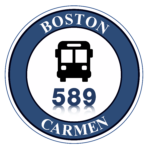MBTA mechanics keep old subway cars rolling
July 8, 2012

Workers have been busy trying to keep up as revenues have failed to keep pace with costs, while ridership has increased.
By Eric Moskowitz | GLOBE STAFF | JULY 08, 2012
MEDFORD — Standing in a pit below an Orange Line car, MBTA repairer Dave Campbell manipulated knobs and buttons to activate the Stanray Wheel Truing Machine, a hulking device in dinged-up avocado green that looks like the offspring of Cold War weaponry and a KitchenAid mixer.
With a deafening whir and a flash of sparks, Campbell shaved the worn, misshapen subway wheel to the proper smoothness and angle needed for a safe and steady ride. The wheel truer was 60 years old; the subway car 31, and it had logged 1.5 million miles.
“I’m using an antique to repair an antique,” said Campbell, part of the team of 57 repairers, sheet-metal workers, carpenters, engineers, and others who staff Medford’s Wellington Carhouse around the clock to keep some of the T’s oldest cars, the Orange Line fleet, operable.
They do it with a mix of old, new, and jury-rigged technology, simulating weather changes with laptops to test 1970s air conditioners, replacing components with scrapped parts salvaged from retired Blue Line cars, and protecting sensitive traction motors from snowdrifts with deli-counter hairnets.
This is the crossroads of the T’s record ridership and its financial crisis.
The preventive maintenance and life-extending repairs performed here and at places such as the Red Line’s Cabot Carhouse have “been the saving grace for the authority,” said Jeffrey D. Gonneville, chief mechanical officer for the Massachusetts Bay Transportation Authority, on a tour of the 125,000-square-foot hangar adjacent to the Orange Line’s Wellington Station.
The Orange Line employs 120 cars, built in the late ’70s and early ’80s and designed to run 25 years — if they had a midlife overhaul to refurbish or replace major components.
They never did.
A nearly $500 million order of 152 modern cars, to replace and expand the fleet, is likely five to 10 years off, part of a $4 billion repair/replacement backlog of vehicle, station, track, signal, and power needs for a system that moves 1.3 million riders each weekday.
Workers have been busy trying to keep up as revenues have failed to keep pace with costs, while ridership has increased.
The T has fallen behind because its revenues, mostly from the state sales tax and fares, have not kept pace with soaring expenses.
Nearly every fare dollar goes to pay off debt, much of it to cover politically popular expansion approved on Beacon Hill without a dedicated financing plan. Costs such as electricity, fuel, and employee health insurance have outstripped inflation.
At the same time, ridership has escalated, driven by gas prices and the growing popularity of living and working near train and subway stations.
That means more people crowding platforms to await older trains and subways, more likely to break down and cause delays — and in need of more short-term repair spending to compensate for deferred long-term investment.
The fiscal year that ended last week was a banner one for the Orange Line. The cars averaged almost 42,000 miles each (or about 1,900 trips from Oak Grove to Forest Hills and back)between failures (measured as breakdowns delaying passengers at least four minutes).
That soundly beat the roughly 30,000-mile recent average. It was not luck but the result of hiring five more repairers and deploying them shrewdly; inspections are conducted more frequently, with preventive work driven by computer analysis of the most common problems, said Joe Keeffe and Steve Hicks, director and deputy director of heavy rail engineering and maintenance.
But old cars can only be sustained for so long.
“While the MBTA has obviously been getting knocked around a little bit, the truth is they do amazing things with the limited resources they have,” said Stephanie Pollack, associate director of Northeastern University’s Dukakis Center for Urban and Regional Policy, and author of a recent report highlighting congestion on the T.
“The good news is they’re making do with less, and they’re managing maintenance better,” Pollack said, invoking a quote attributed to Churchill (“Gentlemen, we are out of money; now we have to think”). “But it’s not a long-term fix.”
There are older cars on the T, including part of the Red Line fleet, but no other major line runs entirely on trains ordered in the 1970s.
The Wellington shop can service 21 cars at a time. Trains runs in six-car sets, travel 280 to 325 miles in a day of service, and come in every 12,000 miles for a multiday inspection, repairs, and a bath.
Much of the carhouse is devoted to those inspections, with the cars passing through stations in which major systems — propulsion, braking, doors, lights, heating, and cooling — are examined and adjusted.
Other space is for emergencies. On this day, car 01276 was up on a lift, so one of its bulky air-conditioning compressors could be fixed for the evening rush after a morning failure.
Throughout the carhouse, old bumps against new.
Employees receive messages on flatscreen displays and clock in and out with a hand-scanner — then work on archaic trains. Where new cars are microprocessor-driven, these have scores of cam-driven relays that open and close when the motorman turns a dial in the cab, determining how much power to feed into the traction motor.
“One broken wire can cause . . . another relay not to pick up, which could end up burning up four motors,” said foreman Tom McHale, pointing out an array of wires, relays, and switches that must work in concert. One failure can kill a car’s motor, forcing other cars on the train to work harder, taxing their components and grinding the train to a halt.
Nearby, a pile of dusty parts — control boards for operator’s cabs, auxiliary locks to keep doors closed in motion, electromagnetic pressure switches to open them when trains are stopped — sat heaped on pallets.
They were salvaged from the Blue Line fleet, fully replaced from 2007 to 2009 at roughly $200 million.
Those Blue Line cars, stubbier versions of these Orange Line trains, were built in the same era by the same manufacturer, Hawker-Siddeley, using many of the same subcontracted components.
“Great train,” Keeffe said.
Indeed, these are the same ones that ran on the elevated Orange Line, a dim memory of old Boston that gave way to the Southwest Corridor subway in 1987.
Purchased largely with a grant from Jimmy Carter’s administration, they must remain in service through the end of the decade, coaxed along by the carhouse team.
Keeffe studied the parts, not just out of production but built by companies that no longer exist.
“It’s worth nothing in scrap,” he said. “And it’s worth [everything] to us.”


Recent Comments